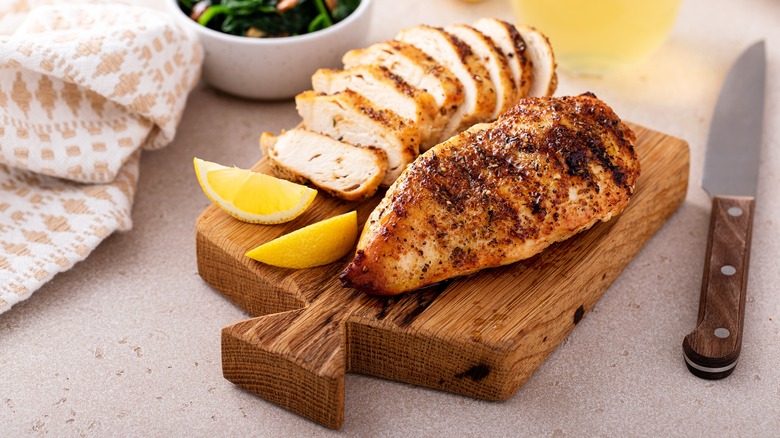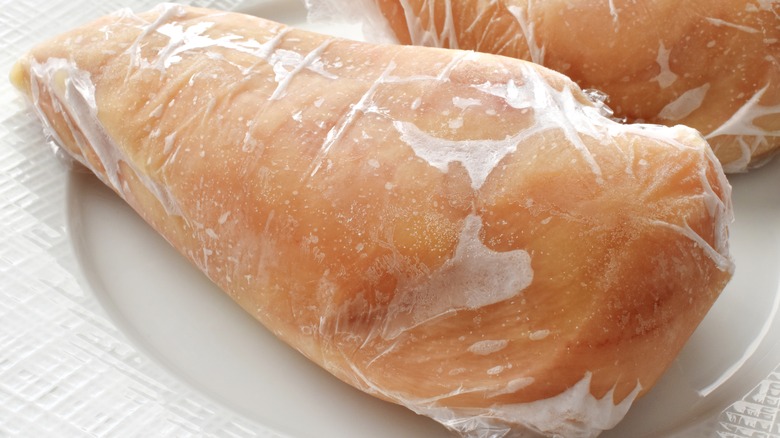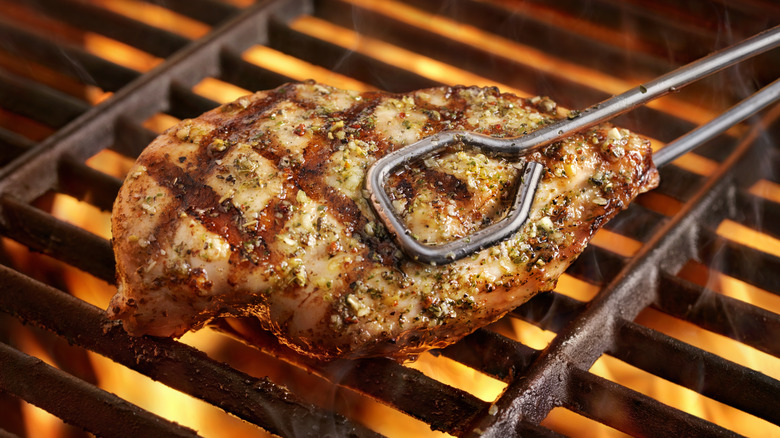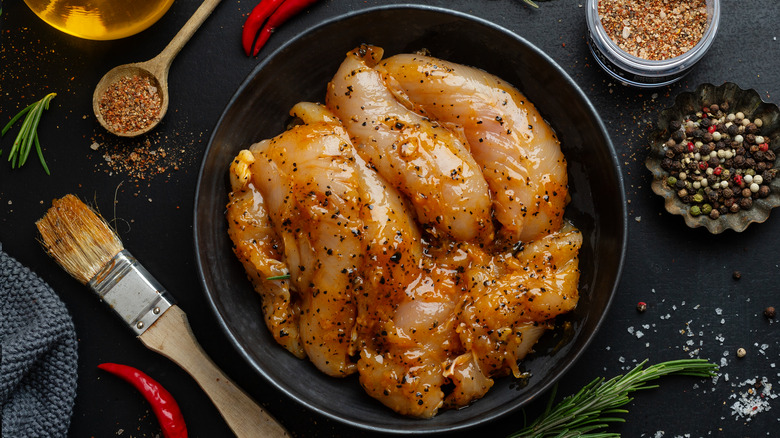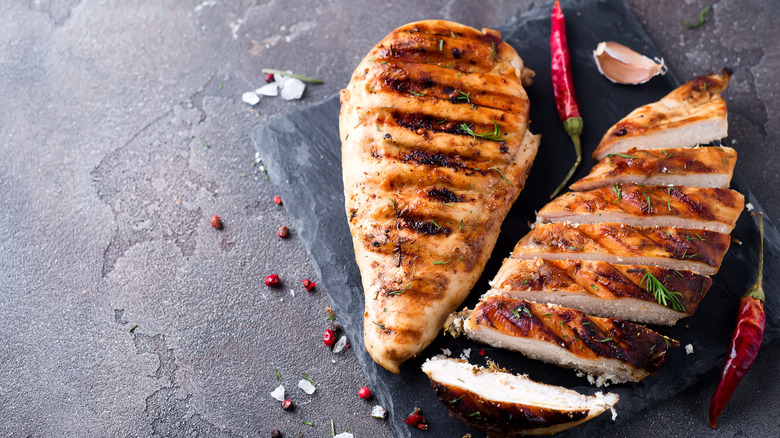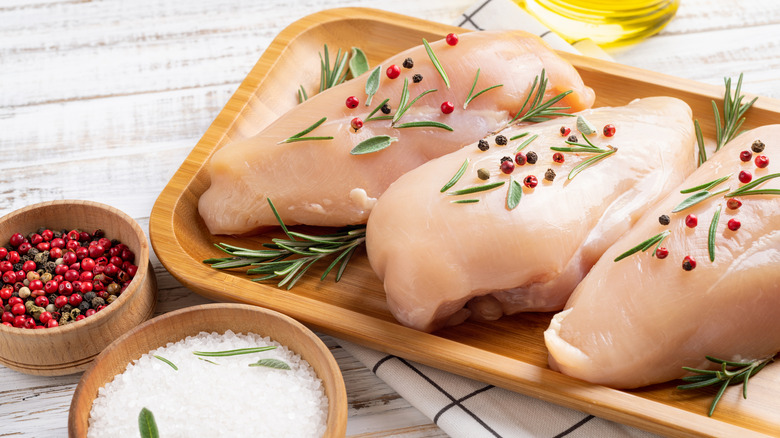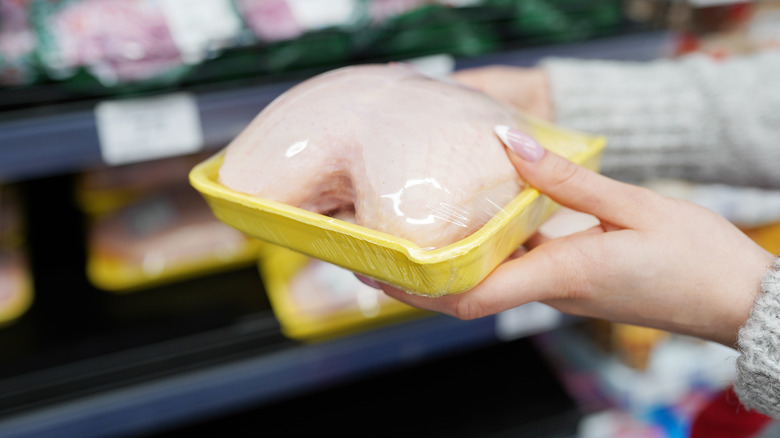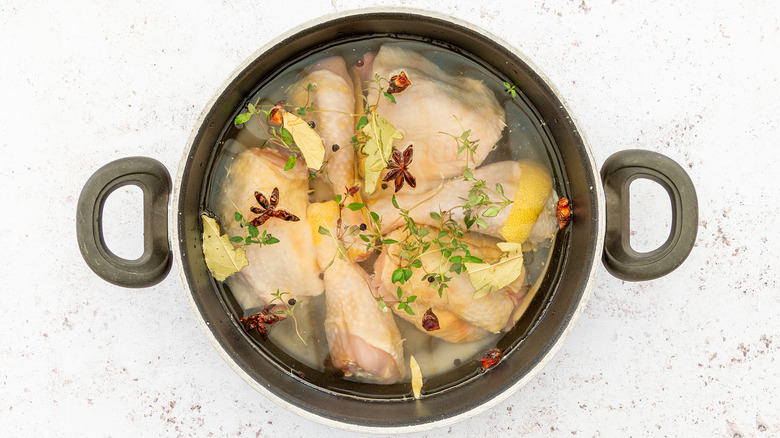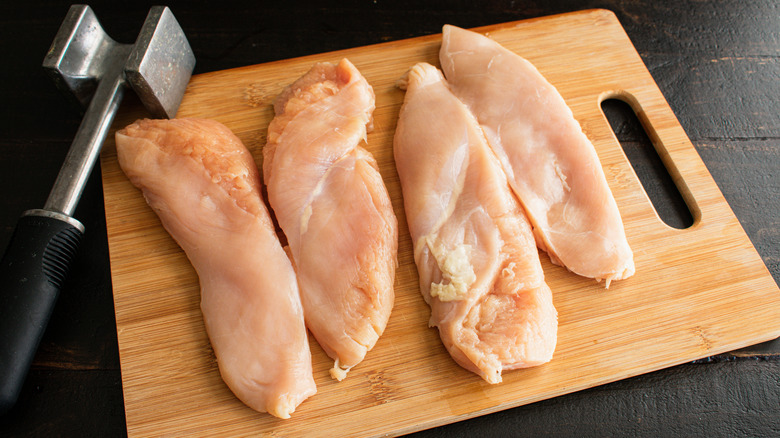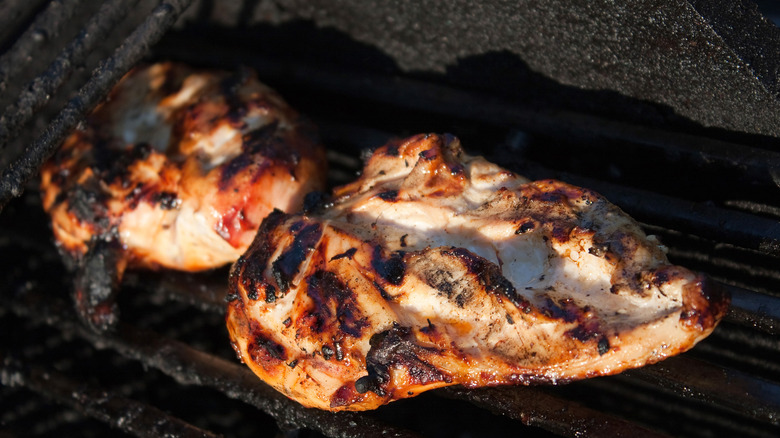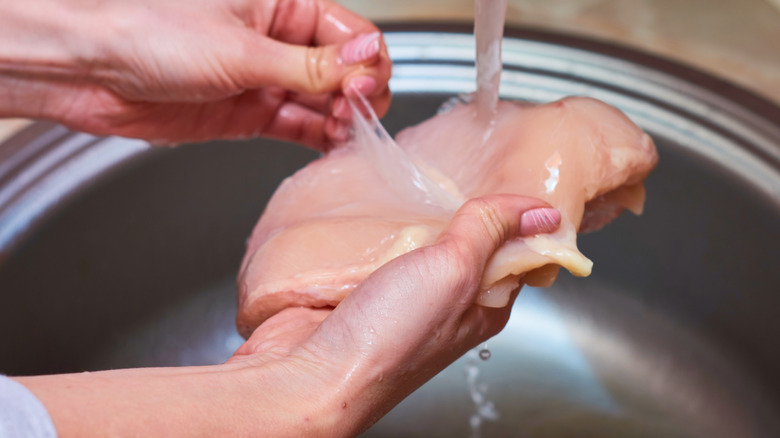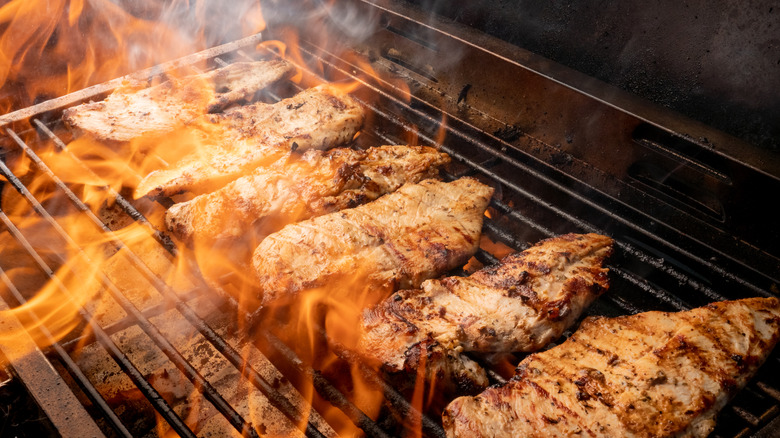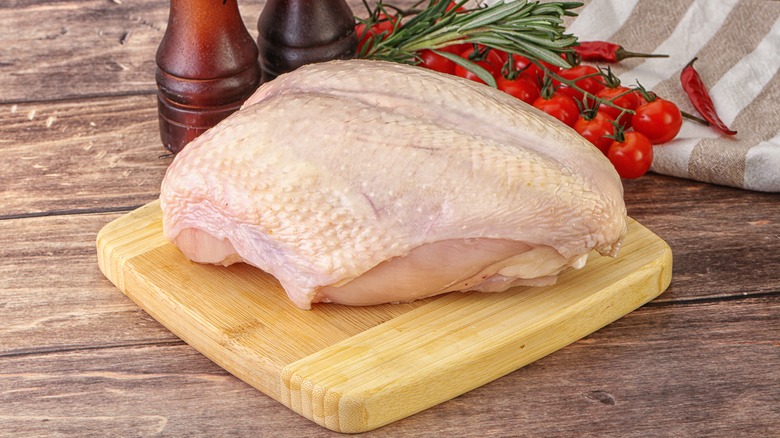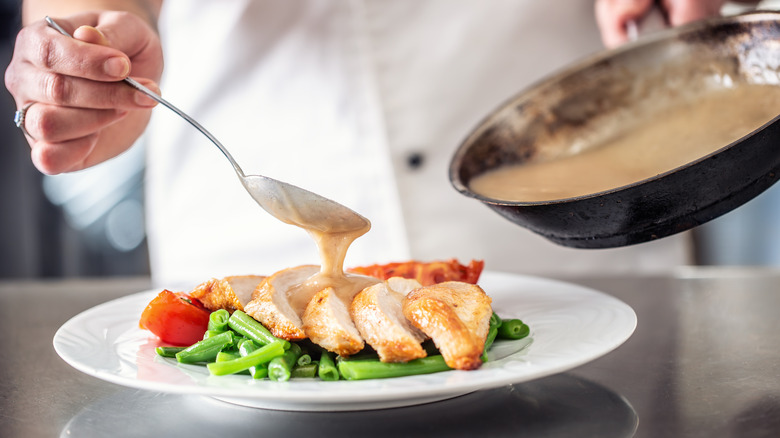13 Mistakes You Might Be Making With Chicken Breasts
Chicken is incredibly versatile, with a multitude of ways to prepare it. However, when you're cooking chicken breasts in particular, it can come with challenges. Whether you're a novice or a natural, mistakes will likely be made. For example, once chicken breasts are overcooked and dry, there's only so much you can do to try to fix it. But, there's plenty you can do to prevent it! Sometimes, the mistake made is as simple as underseasoning, which is easier to correct. Other blunders can ruin a dinner.
It all comes down to understanding how to work with chicken breast, and why these mistakes are so easy to make. Of all the cuts of chicken, breasts tend to be larger. This means you have to pay attention, not only to seasoning or cooking time but to the entire preparation. Fret not — cooking chicken is not particularly difficult to perfect; it just might take some patience and practice! Here, we'll delve into some of the mistakes you might be making when cooking with chicken breasts and how you can fix them if something goes awry.
1. Cooking cold chicken
The mistake of cooking chicken breasts when they're still cold might have never crossed your mind. After all, you defrost it, you pull it from the fridge, and you get started. Right? Well, this isn't actually the best method. Raw chicken should definitely be kept cold until it's fully thawed. Ideally, it should be brought to room temperature before you start cooking it. Not only does doing this decrease the overall cooking time, but it also allows the fibers in the meat to relax, resulting in a more tender and succulent texture.
Moreover, when you cook chicken that is at room temperature, it cooks more evenly. If it's still cold, you're more likely to end up with a burnt exterior and a potentially raw interior. But, if you let it sit on the counter for a half hour or so (remember, don't let it sit out for 2 or more hours or you risk bacteria growth, per the U.S. Department of Health & Human Services), the interior of the chicken will start cooking more quickly. Plus, you're more likely to get a crispy outside than a burnt one.
2. Sticking to the same cooking method
One of the easier-to-correct mistakes is always using the same cooking method when you cook chicken breasts. For example, grilling chicken breasts can take time and practice to ensure you get a crispy, charred exterior — but not totally blackened — and a juicy center, but you'll get that distinct, smoky flavor. On the other hand, roasting chicken can amp up the flavors, get that same crispy skin and moist meat, and lock in delicious juices.
Other methods include poaching, which is less damaging than boiling because it relies on simmering rather than a rapid boil, which can affect the overall moisture. Poaching or slowly boiling chicken is one of the best ways to get tender, shredded chicken. Start by bringing the chicken to a gentle boil using cold, seasoned water, and then lower the heat and cover it with a lid to simmer it until it's easy to shred. You could also try using a pressure cooker to get pull-apart chicken.
Then, there's always fried chicken. Chicken breasts can sometimes be tricky to fry because you don't want to burn the batter before the center is cooked through. Pan-frying, oven-frying, and deep-frying are all popular options, but you'll want to check your meat with a thermometer before eating it to make sure your chicken isn't still raw inside. There are so many exciting ways to cook chicken breast, so this mistake is very avoidable if you're willing to get creative in the kitchen.
3. Forgetting to use a marinade
Even though a marinade isn't completely necessary, opting to omit it can be a mistake because, without one, you won't be making the most out of your meat. Several marinades, from buttermilk to citrus juice and herbs, can tenderize, add moisture, and increase the flavor of chicken breasts. Marinades are also the key to cooking frozen chicken breast so it stays moist, especially since frozen chicken breast can tend to be drier than fresh poultry.
Generally, a marinade requires some kind of acidic liquid (such as citrus juice, wine, or vinegar), an oil, and a seasoning. With such a broad set of rules, you can get creative with your marinade. For instance, buttermilk is slightly acidic, so it's a popular choice, particularly for fried chicken, because it breaks down the fibers in the meat while being creamier and less acidic than lemon juice or vinegar. A simple combination of buttermilk, salt, pepper, oil, and herbs can bring your otherwise plain chicken to another level.
You don't want to marinate chicken for too much time. A full day is too long because the chicken could break down too much and turn mushy in texture. Usually, 30 minutes to an hour is plenty of time for the chicken breasts to soak up the flavors and liquid and become more tender. And, the CDC advises to keep marinating meat in the fridge as opposed to the countertop to avoid bacterial growth.
4. Not allowing the chicken to rest
A good rule of thumb for almost any meat is to let it rest for a while before serving it. With chicken, this is no exception. Not just grilled or roasted chicken, but you should also rest fried chicken before eating it. Cutting into chicken too early can release all the juices, risking it going dry. Aside from overcooking it, not letting the meat rest is one of the primary reasons it often dries out. By letting it sit and rest, you can lock in flavors and moisture until right before it's time to eat it.
Allowing your meat to rest isn't a new concept, but you might not have realized it's important for chicken, too. Steak is one of the more common meats that need to sit before it's sliced, but technically all meat should rest. Juices rise to the top when meat is cooking, so if you cut it too early, they are going to escape right away. Instead, you should check the temperature of your meat with a thermometer. For chicken, it needs to be at 165 degrees. After the temperature has reached about 160 degrees, you should let the chicken sit for about 5 to 10 minutes. Not only will it lock those juices in, but it will keep on cooking for a while, too. In just 10 minutes, the internal temperature could rise another 10 degrees.
5. Going too easy on the seasonings
We're just going to say it: Bland chicken is pretty unappetizing. Liberal seasoning makes a huge difference, so you don't want to reel it back when it comes to spices. While the flavors you create are for your own preference, going light on the seasoning is a common mistake that isn't always easily corrected. Sure, you can always add more seasoning at the end to correct bland chicken, but incorporating it early on is also essential to creating a depth of flavor. Some chefs, like Gordon Ramsay, suggest seasoning your meat throughout the cooking process – before, during, and after — so it's evenly coated.
What seasonings to use is all on you. From herbs to spices, there are an array of options. The main point is to go big. However, you don't want to go so big that you can't take away unbalanced flavors. For instance, if you use too much paprika or cayenne you'll have a hard time counteracting that heat. Moreover, don't forget the basics. Salt and pepper are crucial for seasoning chicken breasts not only because they add flavor, but salt naturally enhances the taste of anything. It does this with chicken by bringing out the juices, which pack a lot of delicious flavor.
6. Cooking wet chicken straight from the package
When cooking chicken, especially on the stovetop or grill, it all comes down to that nice, crispy sear. If you cook your chicken still wet from the packaging, you're not likely to get that. You should pat meat dry before cooking it because excess moisture can create steam that will interfere with getting an even, beautifully colored sear. Plus, when you're seasoning, a dry rub works best on dry chicken — how else will it stick? All you need to do is remove the chicken and lay it out on a towel and gently pat it dry. You can do this with paper towels or cloth towels, just make sure you aren't leaving any fluffs or lint behind.
The only real exception here is with fried chicken, and only because it's typically dredged in eggs, flour, breadcrumbs, or the like, before going into the oil. So technically, it's already wet by the time it starts cooking. Still, you'll have better luck with dredging and coating your chicken if you aren't fighting against wet chicken straight from the package.
7. Not using a salt brine
Using a brine can elevate the flavor of chicken breasts. A simple liquid brine usually consists of kosher salt, sugar, and water. Adding herbs and other seasonings, much like you would with a marinade, will also help elevate the brine's flavor profile. However, as long as you're using salt to brine, you're going in the right direction, because it's the salt that pulls the juices out of the chicken and brings out that natural flavor. If you're using a wet brine like this, the key is to let the mixture boil so everything can dissolve and blend together, and then let the liquid fully cool before using it on the chicken. You can soak the chicken in the liquid for up to 2 days in the fridge. Unlike a marinade, it's okay to keep it submerged for a longer amount of time.
A dry brine also works perfectly well. For this method, you use a mixture of salt, sugar, and seasonings without the water and rub it directly on the chicken. This method doesn't require as much time. You can leave it on the chicken for a couple of hours in the fridge. Remember, one of the earlier mistakes was cooking cold, wet chicken, and that still applies here. After brining the chicken, you'll want to pull the chicken from the fridge, gently clean off the brine, pat it dry, and let it come to room temperature before cooking it.
8. Not flattening the chicken out
For an even cook, the chicken breast should be flattened until it's all the same thickness. If you don't flatten it out and your breasts or chopped pieces are all different sizes, they are going to cook at different speeds. Bigger pieces aren't going to cook as quickly as smaller ones, and you could risk undercooking them. Not only that but chicken breasts thicker at one end and then taper to a thinner end. This means one whole breast could cook unevenly if it's not the same thickness. Plus, thinner meats mean less cooking time.
To flatten out chicken breasts, either use a meat mallet or a flat-bottomed cup. While it definitely tenderizes the meat, when using a meat mallet to pound out chicken breast, you need to be careful or you could end up ripping it. Instead of beating it, gently and evenly pound out the breast. With a glass cup, you essentially do the same thing but you could decrease the chance of tearing in the meat because of the flat bottom. Alternatively, you can butterfly chicken breasts to get an even thickness. To do this, carefully slice the breast in half length-wise, leaving the opposite edge untouched. When you fold it out, it should all be one thin piece of meat.
9. Undercooking or overcooking it
When aiming for the perfectly cooked chicken breast, a lot of it comes down to cooking time. One of the biggest mistakes when preparing this poultry cut is overcooking it or undercooking it. In either case, you risk a ruined meal. We can all agree that overcooked chicken results in a dry, hard-to-swallow texture. Once it's past its prime cooking time, there's only so much that can be done to correct it. But, by using a foil tent in the oven, you can trap heat and steam while removing it from the direct heat. Also, pay attention to general cooking times: Bone-in breasts should roast in the oven for about 30 to 40 minutes at 350 degrees, and about 20 to 30 minutes for boneless breasts. On the grill, you should be cooking breasts for an average of 10 minutes for each side.
While overcooking chicken can produce an unappetizing meal, undercooking chicken is downright dangerous. The ideal temperature for chicken breasts is 165 degrees, and anything lower could mean you still have raw parts. Raw chicken can contain salmonella or other bacteria, and can potentially cause food poisoning (per USDA). One of the best, and easiest, ways to avoid undercooked chicken breasts is to check it with a meat thermometer before deeming it ready.
10. Rinsing it before cooking it
While you might feel inclined to wash your chicken during preparation, this is actually a regular mistake. Chicken breasts are just one of many foods you don't actually have to wash. Some think washing meats is cultural, a method passed down from generations of kitchens. But, what does rinsing actually do? It might seem like it could help clean any germs and wash away the juices in the packaging. Plus, who knows who handled it in the packing process? To many, cleaning it could sound like a good idea.
On the contrary, instead of rinsing germs away, washing chicken can actually spread bacteria around the kitchen and create more trouble. As the USDA explains, washing your chicken can cause cross-contamination — bacteria on the raw chicken can be carried around your kitchen from droplets of splashed water. It could happen without you even realizing it, and if you don't clean it up, you risk bacteria staying on countertops. Instead, the best way to eliminate germs is to cook the chicken fully, without rinsing.
11. Using too much heat
If your chicken breasts are cooking too quickly, leaving you with a burnt exterior and raw center, then you're very likely making the mistake of using too much heat. When the heat is too high while cooking chicken breasts, they're likely to burn to a crisp on the outside before fully cooking on the inside. This is mainly because chicken breasts are a thicker cut of the bird, so the inside just doesn't cook as quickly as the rest, especially when they're larger. A higher heat setting could particularly be detrimental to chicken breasts that haven't been pounded out to the same thickness.
Rather than using high heat, it's best to use medium heat in the oven, such as a typical 350 degrees. Medium heat is also ideal for cooking on the stovetop — you can also cover it with a lid to help speed up the cooking without burning it before the inside of the chicken is done. Trust us, you can still get a nice, crispy sear without super high heat. If anything, start with high heat to get that quick sear, and then immediately lower it to a medium or medium-low setting and you can even cover it as well. The same process would work on the grill. Another option is using a crockpot, which can cook the chicken fully throughout the day on low heat.
12. Just using boneless and skinless
Bone-in chicken breasts can take longer to cook, but it's only by a few minutes. So, if you're only opting for boneless, skinless chicken breasts because they take a little less time to prepare, then this is your sign to try another way. Bone-in chicken breasts are just as tasty as the deboned ones. And, some argue that roasting a bone-in chicken, particularly a whole one, can hold a whole lot more flavor than boneless, skinless cuts.
When it comes to chicken breasts, try going bone-in next time to see for yourself if there's a great difference in flavor. Not only can bones help keep chicken moist, but they also contain fat which packs a lot of flavor. Plus, they can also provide some extra support to the structure of chicken, especially when flipping them. Skin also holds in moisture and flavor, and can act as a barrier to the rest of the meat which will enhance the crispy sear.
13. Not trying to correct your mistakes
Perhaps one of the most unrealized mistakes is not trying to fix it when something goes wrong. Sometimes, a meal can't be saved in a decent way, and we've got to cut our losses and try again another time. But, that's not always the case. Luckily, there are plenty of ways to save chicken breasts if you make a mistake. A little too heavy on seasonings? Add a fatty or creamy element to dial it back. A quick sauce can do the trick with chicken that's gotten overly dry by giving it back some moisture. While it won't totally restore the juices in an extremely overcooked chicken, it can definitely disguise a dry mishap.
However, some things can be fixed if you just catch them early enough. If you're cooking chicken in a skillet and it's starting to get extra crispy while it's still raw on the inside, start basting it with some butter. You could also try pouring some stock into the skillet and covering it with a lid to help it cook faster without drying out. With an oven, if it's starting to cook too quickly, you can reverse this mistake by switching to the dry-poaching method. All you do is make a tent of parchment paper over the roasting pan, and let the steam do the cooking while protecting the exterior.
